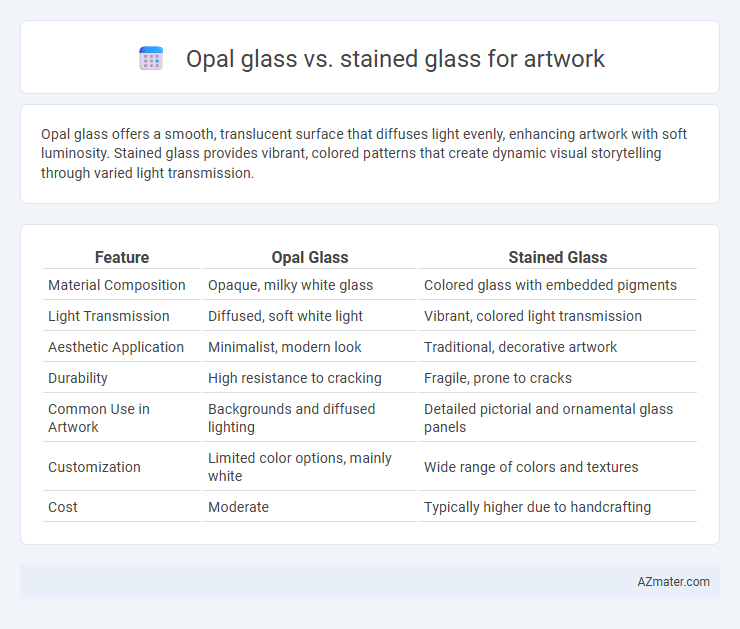Opal glass offers a smooth, translucent surface that diffuses light evenly, enhancing artwork with soft luminosity. Stained glass provides vibrant, colored patterns that create dynamic visual storytelling through varied light transmission.
Table of Comparison
| Feature | Opal Glass | Stained Glass |
|---|---|---|
| Material Composition | Opaque, milky white glass | Colored glass with embedded pigments |
| Light Transmission | Diffused, soft white light | Vibrant, colored light transmission |
| Aesthetic Application | Minimalist, modern look | Traditional, decorative artwork |
| Durability | High resistance to cracking | Fragile, prone to cracks |
| Common Use in Artwork | Backgrounds and diffused lighting | Detailed pictorial and ornamental glass panels |
| Customization | Limited color options, mainly white | Wide range of colors and textures |
| Cost | Moderate | Typically higher due to handcrafting |
Introduction to Opal Glass and Stained Glass
Opal glass is a translucent, milky white glass known for its smooth, even diffusion of light, making it ideal for creating soft, luminous effects in artwork. Stained glass features vibrant, colored pieces assembled into intricate designs, often used in windows and decorative panels to produce vivid, light-filtered imagery. Both materials offer unique aesthetic qualities, with opal glass emphasizing subtle glow and stained glass showcasing bold, colorful narratives.
Key Material Differences
Opal glass is characterized by its translucent, milky white appearance that diffuses light evenly, making it ideal for backlit artwork and creating a soft, uniform glow. Stained glass consists of colored glass pieces joined by lead came or copper foil, offering vibrant hues and intricate designs with varied light transmission depending on thickness and paint used. The key material difference lies in opal glass's consistent translucency versus stained glass's colorful opacity and texture, influencing artistic style and light interplay in installations.
Visual Aesthetics and Light Interaction
Opal glass offers a smooth, diffuse glow that evenly scatters light, enhancing artwork with a soft, muted luminosity ideal for modern, minimalist designs. Stained glass provides vibrant, saturated colors with intricate patterns, creating dynamic light reflections and shadows that transform spaces with rich, narrative visuals. The choice between opal and stained glass depends on desired light diffusion and color intensity, impacting the artwork's visual depth and atmospheric presence.
Color Options and Design Flexibility
Opal glass offers a wide range of milky, translucent color options that provide soft, even light diffusion ideal for subtle and modern artwork lighting. Stained glass boasts vibrant, rich colors with intricate patterns achieved through combining colored glass pieces, giving artists extensive freedom to create detailed and varied designs. Both materials allow unique expression, but opal glass emphasizes uniformity and minimalism, while stained glass excels in vivid color variety and complex, customizable textures.
Durability and Maintenance
Opal glass offers superior durability compared to stained glass due to its thicker, more uniform composition, which resists cracking and chipping over time. Maintenance for opal glass is simpler, requiring only regular cleaning with mild soap and water, whereas stained glass often demands careful inspection and potential lead came restoration to preserve its integrity. Stained glass, while visually striking, is more susceptible to environmental damage and requires specialized upkeep to prevent deterioration of the colored segments and solder joints.
Suitability for Indoor vs Outdoor Use
Opal glass offers excellent durability and UV resistance, making it highly suitable for outdoor artwork exposed to varying weather conditions, while maintaining consistent light diffusion indoors. Stained glass, known for its vibrant colors and intricate designs, is more sensitive to environmental factors such as moisture and temperature fluctuations, often requiring indoor placement or protective coverings when used outdoors. Choosing between opal and stained glass depends on the artwork's location, with opal glass preferred for longevity in outdoor installations and stained glass favored for decorative indoor displays.
Artistic Techniques and Applications
Opal glass offers a smooth, diffused light effect ideal for techniques like sandblasting and acid etching, enhancing subtle textures and monochromatic designs in artwork. Stained glass provides vibrant color segmentation through leading and painting, allowing intricate patterns and vivid narratives in windows and decorative panels. Artists choose opal glass for contemporary, minimalist aesthetics and stained glass for traditional, colorful storytelling applications.
Cost Comparison
Opal glass typically costs less than stained glass due to its simpler manufacturing process, making it a budget-friendly option for artwork. Stained glass involves intricate color application and hand-crafted designs, which increase labor costs and overall price. For projects prioritizing cost-efficiency, opal glass offers a more affordable yet visually appealing alternative.
Environmental Impact
Opal glass offers a lower environmental impact compared to stained glass due to its simpler manufacturing process and reduced energy consumption during production. Stained glass often involves heavy metals and pigments that can release toxins and require careful disposal to avoid environmental contamination. Choosing opal glass supports sustainable art practices by minimizing hazardous waste and reducing carbon emissions in the glassmaking industry.
Choosing the Right Glass for Your Art Project
Opal glass offers a smooth, milky translucency that diffuses light evenly, ideal for modern artwork requiring subtle illumination and soft color transitions. Stained glass features vibrant colors and intricate patterns, making it perfect for detailed, traditional designs that emphasize bold visuals and storytelling through light. Selecting between opal and stained glass depends on the desired aesthetic effect, lighting conditions, and the complexity of the art project's design.

Infographic: Opal glass vs Stained glass for Artwork
 azmater.com
azmater.com